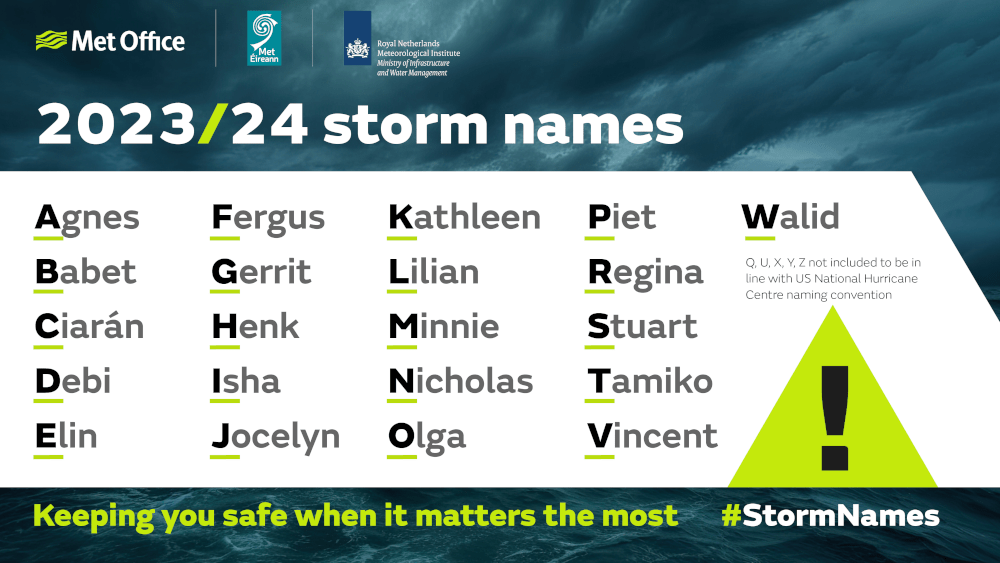Why do storms have names?
In the UK, an organisation called the Met Office closely monitors the weather. Met is short for meteorological, which relates to the weather.
The Met Office works in partnership with Met Éireann (the Irish Met Office) and KNMI (The Dutch National Weather Forecasting Service) to name storms.
The partnership started naming storms in 2015 to help people become more aware and prepared when bad weather is coming. They got this idea from how they do things in America, where they started naming storms in 1950!
You might remember hearing about storms on the news, like Storm Francis, Storm Dennis, or Storm Eunice. This year, they are naming some storms after heroes who have helped others during extreme weather events.
What are the UK storm names for the autumn and winter of 2023-2024?
UK Storm Names 2023-24 – Source – Met Office
Wondering how they choose the names?
Since September 2015, the Met Office has asked people to suggest names. They take the most popular suggestions and team up with Met Eireann, the Irish version of the Met Office, to create a list of names. Sometimes storms from other countries keep their original names, even if they don’t fit into the UK’s alphabetical naming system, like Storm Jorge, which came from Spain.
To avoid confusion over naming, if a storm is the remnants of a tropical storm or hurricane that has moved across the Atlantic, the name would not be changed. It would follow the established method of being referred to as ‘ex-hurricane Ophelia’, for example.
Only storm names officially designated by the National Weather Service in the US are used for this.
Can I name a storm?
A new list of names will be compiled jointly between Met Éireann, the Met Office and KNMI (The Dutch National Weather Forecasting Service).
Everyone is welcome to suggest names for future consideration via email to [email protected] or through their online form. Any future names for the Met Office component of the list may be compiled from these suggestions.
Which storms are named?
The Met Office doesn’t just name any storm; it has to be big and with the potential to cause much damage. They use amber and red warnings to indicate a storm’s danger; only the storms that earn these warnings get a name.
Storms will usually be named based on the impacts of strong winds, but the effects of other weather types will also be considered. For example, rain, if its impact could lead to flooding as advised by the Environment Agency, SEPA and Natural Resources Wales flood warnings, or snow. Therefore, ‘storm systems’ could be named based on impacts from the wind but also include the impacts of rain and snow.
When the criteria for naming a storm are met, either the Met Office, Met Éireann or KNMI can name a storm, taking the name from the latest list in alphabetical order.
They then let the public, governments, the community and the media know through various routes, including publishing details on their websites and social media channels.
You might be curious how they decide whether to give a storm a girl’s or a boy’s name. It alternates between the two! Strangely, studies have found that storms with female names can sometimes be more dangerous because people find female names less threatening, which is not good!
As for which name is picked first from the list, they use them in alphabetical order. Still, you won’t see any storms starting with Q, U, X, Y, or Z because it’s tough to find names beginning with those letters, and they want to keep things consistent with the US National Hurricane Centre’s system.
So remember, naming storms is a way to help us stay safe and prepared, and if you ever come up with a cool name, you can suggest it to the Met Office!


